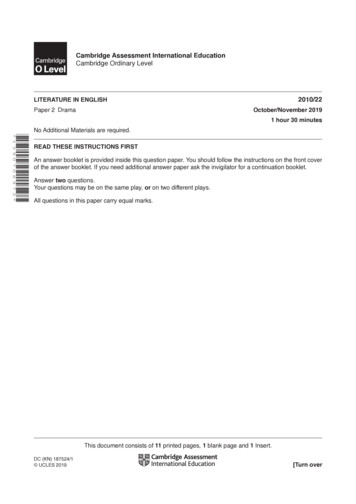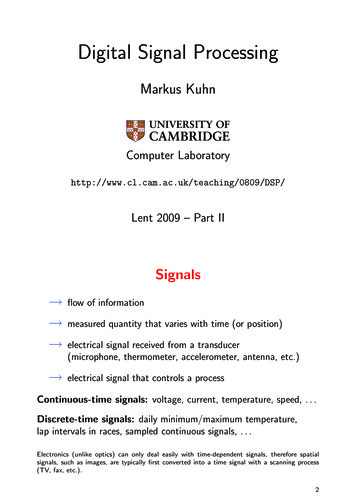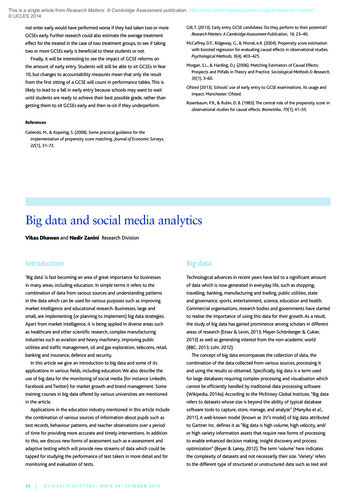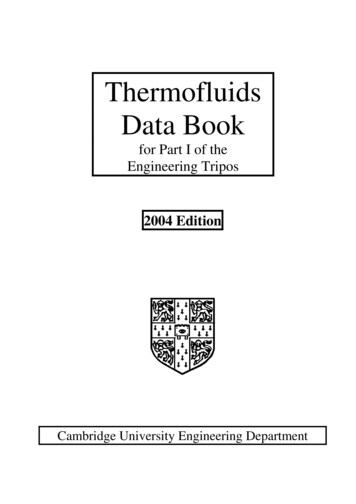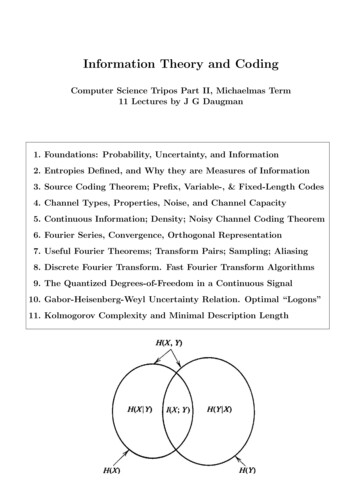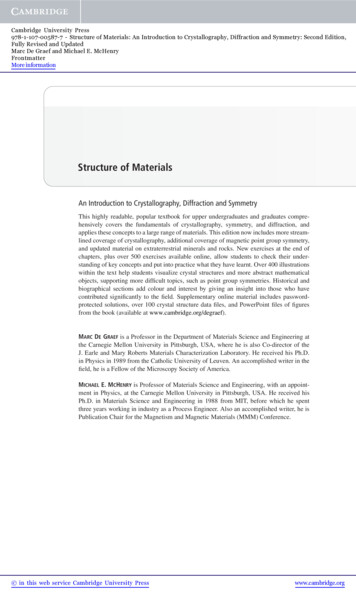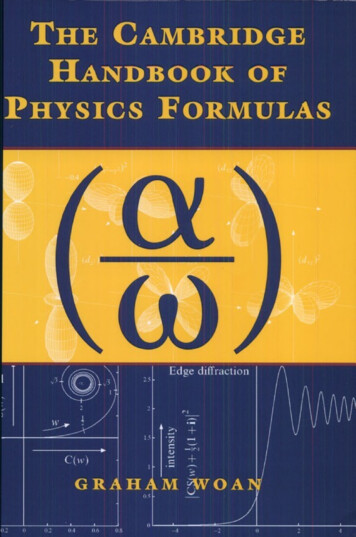
Transcription
mainApril 22, 200315:22This page intentionally left blank
mainApril 22, 200315:22The Cambridge Handbook of Physics FormulasThe Cambridge Handbook of Physics Formulas is a quick-reference aid for students and professionals in the physical sciences and engineering. It contains more than 2 000 of the mostuseful formulas and equations found in undergraduate physics courses, covering mathematics,dynamics and mechanics, quantum physics, thermodynamics, solid state physics, electromagnetism, optics, and astrophysics. An exhaustive index allows the required formulas to belocated swiftly and simply, and the unique tabular format crisply identifies all the variablesinvolved.The Cambridge Handbook of Physics Formulas comprehensively covers the major topicsexplored in undergraduate physics courses. It is designed to be a compact, portable, referencebook suitable for everyday work, problem solving, or exam revision. All students andprofessionals in physics, applied mathematics, engineering, and other physical sciences willwant to have this essential reference book within easy reach.Graham Woan is a senior lecturer in the Department of Physics and Astronomy at theUniversity of Glasgow. Prior to this he taught physics at the University of Cambridgewhere he also received his degree in Natural Sciences, specialising in physics, and hisPhD, in radio astronomy. His research interests range widely with a special focus onlow-frequency radio astronomy. His publications span journals as diverse as Astronomy& Astrophysics, Geophysical Research Letters, Advances in Space Science, the Journal ofNavigation and Emergency Prehospital Medicine. He was co-developer of the revolutionaryCURSOR radio positioning system, which uses existing broadcast transmitters to determineposition, and he is the designer of the Glasgow Millennium Sundial.
mainApril 22, 200315:22
mainApril 22, 200315:22The Cambridge Handbook ofPhysics Formulas2003 EditionGRAHAM WOANDepartment of Physics & AstronomyUniversity of Glasgow
Cambridge, New York, Melbourne, Madrid, Cape Town, Singapore, São PauloCambridge University PressThe Edinburgh Building, Cambridge , UKPublished in the United States of America by Cambridge University Press, New Yorkwww.cambridge.orgInformation on this title: www.cambridge.org/9780521573498 Cambridge University Press 2000This publication is in copyright. Subject to statutory exception and to the provision ofrelevant collective licensing agreements, no reproduction of any part may take placewithout the written permission of Cambridge University Press.First published in print format 2000 - - - - - - eBook (EBL) - - - eBook (EBL) - - - - - - hardback - - - hardback - - - - - - paperback - - - paperbackCambridge University Press has no responsibility for the persistence or accuracy of sfor external or third-party internet websites referred to in this publication, and does notguarantee that any content on such websites is, or will remain, accurate or appropriate.
mainApril 22, 200315:22ContentsPrefacepage viiHow to use this book113Units, constants, and conversions1.1 Introduction, 3 1.2 SI units, 4 1.3 Physical constants, 6 1.4 Converting between units, 10 1.5 Dimensions, 16 1.6 Miscellaneous, 182Mathematics192.1 Notation, 19 2.2 Vectors and matrices, 20 2.3 Series, summations,and progressions, 27 2.4 Complex variables, 30 2.5 Trigonometric andhyperbolic formulas, 32 2.6 Mensuration, 35 2.7 Differentiation, 40 2.8 Integration, 44 2.9 Special functions and polynomials, 46 2.10 Roots of quadratic and cubic equations, 50 2.11 Fourier seriesand transforms, 52 2.12 Laplace transforms, 55 2.13 Probability andstatistics, 57 2.14 Numerical methods, 603Dynamics and mechanics633.1 Introduction, 63 3.2 Frames of reference, 64 3.3 Gravitation, 663.4 Particle motion, 68 3.5 Rigid body dynamics, 74 3.6 Oscillatingsystems, 78 3.7 Generalised dynamics, 79 3.8 Elasticity, 80 3.9 Fluid dynamics, 844Quantum physics894.1 Introduction, 89 4.2 Quantum definitions, 90 4.3 Wavemechanics, 92 4.4 Hydrogenic atoms, 95 4.5 Angular momentum, 98 4.6 Perturbation theory, 102 4.7 High energy and nuclear physics, 1035Thermodynamics5.1 Introduction, 105 5.2 Classical thermodynamics, 106 5.3 Gaslaws, 110 5.4 Kinetic theory, 112 5.5 Statistical thermodynamics, 114 5.6 Fluctuations and noise, 116 5.7 Radiation processes, 118105
main6April 22, 200315:22Solid state physics1236.1 Introduction, 123 6.2 Periodic table, 124 6.3 Crystallinestructure, 126 6.4 Lattice dynamics, 129 6.5 Electrons in solids, 1327Electromagnetism1357.1 Introduction, 135 7.2 Static fields, 136 7.3 Electromagnetic fields(general), 139 7.4 Fields associated with media, 142 7.5 Force, torque,and energy, 145 7.6 LCR circuits, 147 7.7 Transmission lines andwaveguides, 150 7.8 Waves in and out of media, 152 7.9 Plasmaphysics, 1568Optics1618.1 Introduction, 161 8.2 Interference, 162 8.3 Fraunhofer diffraction,164 8.4 Fresnel diffraction, 166 8.5 Geometrical optics, 168 8.6 Polarisation, 170 8.7 Coherence (scalar theory), 172 8.8 Lineradiation, 1739Astrophysics1759.1 Introduction, 175 9.2 Solar system data, 176 9.3 Coordinatetransformations (astronomical), 177 9.4 Observational astrophysics, 179 9.5 Stellar evolution, 181 9.6 Cosmology, 184Index187
mainApril 22, 200315:22PrefaceIn A Brief History of Time, Stephen Hawking relates that he was warned against includingequations in the book because “each equation. would halve the sales.” Despite this direprediction there is, for a scientific audience, some attraction in doing the exact opposite.The reader should not be misled by this exercise. Although the equations and formulascontained here underpin a good deal of physical science they are useless unless the readerunderstands them. Learning physics is not about remembering equations, it is about appreciating the natural structures they express. Although its format should help make some topicsclearer, this book is not designed to teach new physics; there are many excellent textbooksto help with that. It is intended to be useful rather than pedagogically complete, so thatstudents can use it for revision and for structuring their knowledge once they understandthe physics. More advanced users will benefit from having a compact, internally consistent,source of equations that can quickly deliver the relationship they require in a format thatavoids the need to sift through pages of rubric.Some difficult decisions have had to be made to achieve this. First, to be short thebook only includes ideas that can be expressed succinctly in equations, without resortingto lengthy explanation. A small number of important topics are therefore absent. Forexample, Liouville’s theorem can be algebraically succinct ( 0) but is meaningless unless is thoroughly (and carefully) explained. Anyone who already understands what representswill probably not need reminding that it equals zero. Second, empirical equations withnumerical coefficients have been largely omitted, as have topics significantly more advancedthan are found at undergraduate level. There are simply too many of these to be sensibly andconfidently edited into a short handbook. Third, physical data are largely absent, althougha periodic table, tables of physical constants, and data on the solar system are all included.Just a sighting of the marvellous (but dimensionally misnamed) CRC Handbook of Chemistryand Physics should be enough to convince the reader that a good science data book is thick.Inevitably there is personal choice in what should or should not be included, and youmay feel that an equation that meets the above criteria is missing. If this is the case, I wouldbe delighted to hear from you so it can be considered for a subsequent edition. Contactdetails are at the end of this preface. Likewise, if you spot an error or an inconsistency thenplease let me know and I will post an erratum on the web page.
mainApril 22, 200315:22Acknowledgments This venture is founded on the generosity of colleagues in Glasgow andCambridge whose inputs have strongly influenced the final product. The expertise of DaveClarke, Declan Diver, Peter Duffett-Smith, Wolf-Gerrit Früh, Martin Hendry, Rico Ignace,David Ireland, John Simmons, and Harry Ward have been central to its production, as havethe linguistic skills of Katie Lowe. I would also like to thank Richard Barrett, MatthewCartmell, Steve Gull, Martin Hendry, Jim Hough, Darren McDonald, and Ken Riley whoall agreed to field-test the book and gave invaluable feedback.My greatest thanks though are to John Shakeshaft who, with remarkable knowledge andskill, worked through the entire manuscript more than once during its production and whoselegendary red pen hovered over (or descended upon) every equation in the book. What errorsremain are, of course, my own, but I take comfort from the fact that without John theywould be much more numerous.Contact information A website containing up-to-date information on this handbook andcontact details can be found through the Cambridge University Press web pages atus.cambridge.org (North America) or uk.cambridge.org (United Kingdom), or directlyat radio.astro.gla.ac.uk/hbhome.html.Production notes This book was typeset by the author in LATEX 2ε using the CUP Times fonts.The software packages used were WinEdt, MiKTEX, Mayura Draw, Gnuplot, Ghostscript,Ghostview, and Maple V.Comments on the 2002 edition I am grateful to all those who have suggested improvements,in particular Martin Hendry, Wolfgang Jitschin, and Joseph Katz. Although this editioncontains only minor revisions to the original its production was also an opportunity toupdate the physical constants and periodic table entries and to reflect recent developmentsin cosmology.
mainApril 22, 200315:22How to use this bookThe format is largely self-explanatory, but a few comments may be helpful. Although it isvery tempting to flick through the pages to find what you are looking for, the best startingpoint is the index. I have tried to make this as extensive as possible, and many equations areindexed more than once. Equations are listed both with their equation number (in squarebrackets) and the page on which they can be found. The equations themselves are groupedinto self-contained and boxed “panels” on the pages. Each panel represents a separate topic,and you will find descriptions of all the variables used at the right-hand side of the panel,usually adjacent to the first equation in which they are used. You should therefore not needto stray outside the panel to understand the notation. Both the panel as a whole and itsindividual entries may have footnotes, shown below the panel. Be aware of these, as theycontain important additional information and conditions relevant to the topic.Although the panels are self-contained they may use concepts defined elsewhere in thehandbook. Often these are cross-referenced, but again the index will help you to locate themif necessary. Notations and definitions are uniform over subject areas unless stated otherwise.
mainApril 22, 200315:22
mainJanuary 23, 200616:61Chapter 1 Units, constants, and conversions1.1IntroductionThe determination of physical constants and the definition of the units with which they aremeasured is a specialised and, to many, hidden branch of science.A quantity with dimensions is one whose value must be expressed relative to one ormore standard units. In the spirit of the rest of the book, this section is based aroundthe International System of units (SI). This system uses seven base units1 (the number issomewhat arbitrary), such as the kilogram and the second, and defines their magnitudes interms of physical laws or, in the case of the kilogram, an object called the “internationalprototype of the kilogram” kept in Paris. For convenience there are also a number of derivedstandards, such as the volt, which are defined as set combinations of the basic seven. Most ofthe physical observables we regard as being in some sense fundamental, such as the chargeon an electron, are now known to a relative standard uncertainty,2 ur , of less than 10 7 .The least well determined is the Newtonian constant of gravitation, presently standing at arather lamentable ur of 1.5 10 3 , and the best is the Rydberg constant (ur 7.6 10 12 ).The dimensionless electron g-factor, representing twice the magnetic moment of an electronmeasured in Bohr magnetons, is now known to a relative uncertainty of only 4.1 10 12 .No matter which base units are used, physical quantities are expressed as the product ofa numerical value and a unit. These two components have more-or-less equal standing andcan be manipulated by following the usual rules of algebra. So, if 1 · eV 160.218 10 21 · Jthen 1 · J [1/(160.218 10 21 )] · eV. A measurement of energy, U, with joule as the unithas a numerical value of U/ J. The same measurement with electron volt as the unit has anumerical value of U/ eV (U/ J) · ( J/ eV) and so on.1 Themetre is the length of the path travelled by light in vacuum during a time interval of 1/299 792 458 of a second.The kilogram is the unit of mass; it is equal to the mass of the international prototype of the kilogram. The secondis the duration of 9 192 631 770 periods of the radiation corresponding to the transition between the two hyperfinelevels of the ground state of the caesium 133 atom. The ampere is that constant current which, if maintained intwo straight parallel conductors of infinite length, of negligible circular cross-section, and placed 1 metre apart invacuum, would produce between these conductors a force equal to 2 10 7 newton per metre of length. The kelvin,unit of thermodynamic temperature, is the fraction 1/273.16 of the thermodynamic temperature of th
4 Quantum physics 89 4.1 Introduction,89 4.2 Quantumdefinitions,90 4.3 Wave mechanics,92 4.4 Hydrogenicatoms,95 4.5 Angularmomentum,98 4.6 Perturbationtheory,102 4.7 Highenergyandnuclearphysics,103 5 Thermodynamics 105 5.1 Introduction,105 5.2 Classicalthermodynamics,106 5.3 Gas
